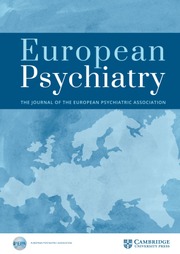Crossref Citations
This article has been cited by the following publications. This list is generated based on data provided by
Crossref.
Rolls, Edmund T.
Loh, Marco
and
Deco, Gustavo
2008.
An attractor hypothesis of obsessive–compulsive disorder.
European Journal of Neuroscience,
Vol. 28,
Issue. 4,
p.
782.
Stein, Dan J.
2008.
Psychobiology of Anxiety Disorders and Obsessive-Compulsive Spectrum Disorders.
CNS Spectrums,
Vol. 13,
Issue. S14,
p.
23.
Menzies, Lara
Chamberlain, Samuel R.
Laird, Angela R.
Thelen, Sarah M.
Sahakian, Barbara J.
and
Bullmore, Ed T.
2008.
Integrating evidence from neuroimaging and neuropsychological studies of obsessive-compulsive disorder: The orbitofronto-striatal model revisited.
Neuroscience & Biobehavioral Reviews,
Vol. 32,
Issue. 3,
p.
525.
Hettinger, Joe A.
Liu, Xudong
Schwartz, Charles E.
Michaelis, Ron C.
and
Holden, Jeanette J.A.
2008.
A DRD1 haplotype is associated with risk for autism spectrum disorders in male‐only affected sib‐pair families.
American Journal of Medical Genetics Part B: Neuropsychiatric Genetics,
Vol. 147B,
Issue. 5,
p.
628.
Goussé, V.
Stilgenbauer, J.-L.
Delorme, R.
Mouren, M.-C.
Michel, G.
and
Leboyer, M.
2009.
Étude des profils cognitifs chez les apparentés de personnes avec autisme : hypothèse d’un manque de flexibilité cognitive ?.
Annales Médico-psychologiques, revue psychiatrique,
Vol. 167,
Issue. 9,
p.
704.
Kawakubo, Yuki
Kuwabara, Hitoshi
Watanabe, Kei-ichiro
Minowa, Michiko
Someya, Toshikazu
Minowa, Iwao
Kono, Toshiaki
Nishida, Hisami
Sugiyama, Toshiro
Kato, Nobumasa
Kasai, Kiyoto
and
Hashimoto, Kenji
2009.
Impaired Prefrontal Hemodynamic Maturation in Autism and Unaffected Siblings.
PLoS ONE,
Vol. 4,
Issue. 9,
p.
e6881.
Gamliel, Ifat
Yirmiya, Nurit
Jaffe, Dena H.
Manor, Orly
and
Sigman, Marian
2009.
Developmental Trajectories in Siblings of Children with Autism: Cognition and Language from 4 Months to 7 Years.
Journal of Autism and Developmental Disorders,
Vol. 39,
Issue. 8,
p.
1131.
Chamberlain, Samuel R
and
Menzies, Lara
2009.
Endophenotypes of obsessive–compulsive disorder: rationale, evidence and future potential.
Expert Review of Neurotherapeutics,
Vol. 9,
Issue. 8,
p.
1133.
Jacob, Suma
Landeros‐Weisenberger, Angeli
and
Leckman, James F.
2009.
Autism spectrum and obsessive–compulsive disorders: OC behaviors, phenotypes and genetics.
Autism Research,
Vol. 2,
Issue. 6,
p.
293.
Dissanayake, Cheryl
Bui, Quang
Bulhak‐Paterson, Danuta
Huggins, Richard
and
Loesch, Danuta Z.
2009.
Behavioural and cognitive phenotypes in idiopathic autism versus autism associated with fragile X syndrome.
Journal of Child Psychology and Psychiatry,
Vol. 50,
Issue. 3,
p.
290.
Viswanath, Biju
Janardhan Reddy, Y.C.
Kumar, Keshav J.
Kandavel, Thennarasu
and
Chandrashekar, C.R.
2009.
Cognitive endophenotypes in OCD: A study of unaffected siblings of probands with familial OCD.
Progress in Neuro-Psychopharmacology and Biological Psychiatry,
Vol. 33,
Issue. 4,
p.
610.
Cavedini, Paolo
Zorzi, Claudia
Piccinni, Monica
Cavallini, Maria Cristina
and
Bellodi, Laura
2010.
Executive Dysfunctions in Obsessive-Compulsive Patients and Unaffected Relatives: Searching for a New Intermediate Phenotype.
Biological Psychiatry,
Vol. 67,
Issue. 12,
p.
1178.
Anholt, Gideon E.
Cath, Danielle C.
van Oppen, Patricia
Eikelenboom, Merijn
Smit, Johannes H.
van Megen, Harold
and
van Balkom, Anton J. L. M.
2010.
Autism and ADHD Symptoms in Patients with OCD: Are They Associated with Specific OC Symptom Dimensions or OC Symptom Severity?.
Journal of Autism and Developmental Disorders,
Vol. 40,
Issue. 5,
p.
580.
Arguello, P. A.
and
Gogos, J. A.
2010.
Cognition in Mouse Models of Schizophrenia Susceptibility Genes.
Schizophrenia Bulletin,
Vol. 36,
Issue. 2,
p.
289.
2010.
Anxiety Disorders.
p.
69.
Abrahams, Brett S.
and
Geschwind, Daniel H.
2010.
Vogel and Motulsky's Human Genetics.
p.
699.
Dowd, Ariane M.
Rinehart, Nicole J.
and
McGinley, Jennifer
2010.
Motor function in children with autism: Why is this relevant to psychologists?.
Clinical Psychologist,
Vol. 14,
Issue. 3,
p.
90.
Gu, Bon-Mi
Kang, Do-Hyung
and
Kwon, Jun Soo
2010.
Understanding Neuropsychiatric Disorders.
p.
247.
Delorme, Richard
Betancur, Catalina
Chaste, Pauline
Kernéis, Solen
Stopin, Astrid
Mouren, Marie‐Christine
Collet, Corinne
Bourgeron, Thomas
Leboyer, Marion
and
Launay, Jean‐Marie
2010.
Reduced 3‐O‐methyl‐dopa levels in OCD patients and their unaffected parents is associated with the low activity M158 COMT allele.
American Journal of Medical Genetics Part B: Neuropsychiatric Genetics,
Vol. 153B,
Issue. 2,
p.
542.
den Braber, A.
van 't Ent, D.
Cath, D. C.
Wagner, J.
Boomsma, D. I.
and
de Geus, E. J. C.
2010.
Brain activation during cognitive planning in twins discordant or concordant for obsessive-compulsive symptoms.
Brain,
Vol. 133,
Issue. 10,
p.
3123.





Comments
No Comments have been published for this article.